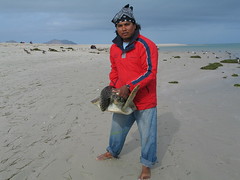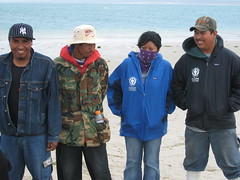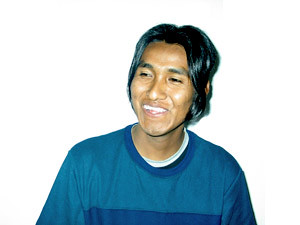Saturday, September 15, 2007
Wednesday, September 5, 2007
Thursday, June 28, 2007
Seri Face 21st Century Challenges: Washington Post
Ancient Tribe at a Crossroads
Mexico's Reclusive Seri Confront the Inevitable
March of Development
By Manuel Roig-Franzia
Washington Post Foreign Service
Thursday, June 28, 2007; A18
PUNTA CHUECA, Mexico -- Gloria Sesma clamps tough stems of desert limberbush between her front teeth, shredding the plant into the floppy strands she needs to weave graceful baskets.
Sesma's lifelong work has worn her top teeth down to tiny stubs, much like the teeth of other women in this remote Gulf of California village, home to Mexico's most reclusive indigenous people, the Seri Indians. She and her daughters adhere to traditional techniques, so it can take 10 months of shredding and weaving to make a single basket.
But Sesma's family also reflects new realities for the Seri, a tribe at a crossroads. While eight of her children married within the tribe, a ninth -- her son, Ezekiel -- piqued the family by breaking with tradition and moving away last year to marry a non-Seri woman.
Now, the Seri desire for insularity is being tested on a larger scale. The inevitable march of development is forcing the Seri to confront fundamental questions about their future, questions that will help determine whether one of the last truly autonomous tribes in Mexico melds into the greater society or stays walled off from the world.
"The community is really at this huge crux point," said Jay Roberts, a professor at Earlham College in Indiana who studies the Seri. "They're a case study for what's happening to indigenous people around the world."
The tribe's two villages -- Punta Chueca and Desemboque -- lie directly in the path of the largest Mexican tourist development in a quarter-century. Under a still-evolving plan, hotels and condominiums will sprout along the coastline in much the same way that another generation of Mexicans transformed Cancun and Acapulco from sleepy outposts to resort havens. Change seems inevitable here, whether the development pierces the Seri's land or merely spreads up to its borders.
The Seri hold dominion over more than 450 square miles of heavenly coastline, where for centuries they have scooped crabs, prowled the desert for medicinal plants and fought to keep away outsiders. They once lived nomadically, moving between fishing encampments on the mainland and their main settlement on Isla Tiburon, Mexico's largest island, which is separated from Punta Chueca by a narrow but treacherous waterway known as Little Hell Channel.
In the 1960s, the Mexican government declared Isla Tiburon a nature preserve and forced the Seri off the island, resettling the tribe in squat cinder-block homes in Punta Chueca and Desemboque. The tribe, which now numbers less than 1,000, lives in harsh desert conditions -- fresh water has to be trucked in, and there is very little modern plumbing.
The Seri make money off the scallops and crabs they take from Little Hell Channel, as well as their baskets and ironwood carvings. Under an agreement with the government, the tribe also receives income from the sale of permits to U.S. hunters, who pay $50,000 or more annually for the right to kill bighorn sheep on Isla Tiburon. The money doesn't go far, though, leaving the Seri in garbage-strewn villages.
Punta Chueca, a four-hour drive from Tucson, is a place of unexplained contradictions. Shiny new cars-- some allegedly stolen -- sit in front of ramshackle homes where the occupants sleep on dirt floors. Stray dogs roam about, while children with dirt-smudged faces go days without soap or water for bathing. Some youngsters return to homes outfitted with satellite television dishes and watch Mexican soap operas.
Though their territory is in Mexico, the Seri don't consider themselves Mexicans -- Mexicans, they say, are people who live outside Seri lands. There have been occasional gunfights between the tribe and authorities from the state of Sonora entering Seri territory to investigate crimes. Sonora's governor, Eduardo Bours Castelo, has complained about "the backwardness of the Seris."
"We're hardheaded," Sesma's husband, Ernesto Molina, 58, said one recent afternoon. "We don't even want visitors. We don't have much contact with the people of Mexico. Mexicans are not welcome here." Molina, who ekes out a living from fishing and guiding the few tourists who can find his village, shuffles between Spanish, which he learned from Mexican fishermen, and the obscure Seri dialect, which Roberts estimates is understood by as few as five non-Seris. The dialect is said to be at its most lyrical when a leatherback turtle beaches and the Seri sing ancient melodies to coax it back to the sea.
Molina considers such traditions sacrosanct and is bothered by the intrusions of outsiders and their ideas. That's why it was so hard for him to swallow what happened a few years ago during another Seri rite, the New Year's celebration on June 30, the end of the tribe's calendar year. A young Mexican visitor caught the eye of his son, Ezekiel, during the festivities. A romance flowered, and not long afterward, Ezekiel announced he wanted to wed. A few other Seri had married outside the tribe, but Molina never thought it would happen in his own family. "I was sad," he said. Ezekiel, though, could not be dissuaded.
"For me, she was a person, even if she wasn't Seri," Ezekiel Molina, now 33, recalled recently. "I don't think that way -- I'm not racist. I reject discrimination."
He left Punta Chueca, crossing the 20 miles of rutted desert path that connects the village to the small beach town of Bahia de Kino. But life outside the village has unfolded badly. He can't adapt to regular work schedules and struggles to raise his daughter with the few pesos he earns from occasional work asa tattoo artist. He says he feels uncomfortable in a society where drug use is common, though in the years since he left his home village, illegal drug use has become a major problem among the Seri. He has thought about moving back, but he isn't sure. Outside the village, he and his family use modern medicine when they get sick. When he returns to the village, he sees his father at the medicine woman's hut, picking up remedies derived from desert plants. His daughter doesn't understand his brothers and
sisters -- she speaks only Spanish. Ezekiel's departure from this village is part of a trickle of Seri, most of whom migrate between Punta Chueca and Bahia de Kino so that their children can attend better schools.
Pedro Torres, 41, the only Seri to earn a doctorate, relocates his family at the beginning of each school year to Bahia de Kino. There, his children discovered Power Rangers cartoons and have become fluent in Spanish. His wife, Blanca Lidia Monroy -- Seri women do not take their husband's last name -- sat in a side yard of her home one recent afternoon weaving baskets while one of her sons flipped through a recently published Seri-Spanish dictionary, the first of its kind. Monroy smiled, flashing the dentures she got to cover the damage done to her teeth by stripping limberbush stems. At the end of each school year, when she returns to Punta Chueca, her neighbors give her funny looks, she said. Some shun her. "Things never change there," she said. "They don't understand why I would leave Punta Chueca for my children's education. They don't understand that I want something more for my children."
Torres, who works an hour's drive away in the city of Hermosillo as a state indigenous education specialist, calls the retirement developments sprouting north of Seri territory a "red alarm" for his people. He shivers when he hears the village elders urging his people to insulate themselves further.
"We have to face reality," Torres said. "Sooner or later, we're going to have this conflict with all this development. They're going to come down here and want to build hotels and we're not going to be prepared to stop them."
The only way to save Seri culture, Torres said, is for young people to leave the villages, get an education, then return empowered by new ideas. Other indigenous peoples in Mexico have done the same, he said, salting local governments and businesses with young professionals while retaining their sense of tribal identity.
But the Seri, he said, are mostly content to wall themselves off. Even the road into their village seems unwelcoming, he said. One recent afternoon, an SUV full of non-Seris rolled toward Punta Chueca. Three young boys waited at the entrance. When they saw the vehicle, they launched a hail of rocks.
© 2007 The Washington Post Company
Ancient Tribe at a Crossroads - washingtonpost.com http://www.washingtonpost.com/wp-dyn/content/article/2007/06/2...
4 of 4 6/28/07 6:34 AM
Mexico's Reclusive Seri Confront the Inevitable
March of Development
By Manuel Roig-Franzia
Washington Post Foreign Service
Thursday, June 28, 2007; A18
PUNTA CHUECA, Mexico -- Gloria Sesma clamps tough stems of desert limberbush between her front teeth, shredding the plant into the floppy strands she needs to weave graceful baskets.
Sesma's lifelong work has worn her top teeth down to tiny stubs, much like the teeth of other women in this remote Gulf of California village, home to Mexico's most reclusive indigenous people, the Seri Indians. She and her daughters adhere to traditional techniques, so it can take 10 months of shredding and weaving to make a single basket.
But Sesma's family also reflects new realities for the Seri, a tribe at a crossroads. While eight of her children married within the tribe, a ninth -- her son, Ezekiel -- piqued the family by breaking with tradition and moving away last year to marry a non-Seri woman.
Now, the Seri desire for insularity is being tested on a larger scale. The inevitable march of development is forcing the Seri to confront fundamental questions about their future, questions that will help determine whether one of the last truly autonomous tribes in Mexico melds into the greater society or stays walled off from the world.
"The community is really at this huge crux point," said Jay Roberts, a professor at Earlham College in Indiana who studies the Seri. "They're a case study for what's happening to indigenous people around the world."
The tribe's two villages -- Punta Chueca and Desemboque -- lie directly in the path of the largest Mexican tourist development in a quarter-century. Under a still-evolving plan, hotels and condominiums will sprout along the coastline in much the same way that another generation of Mexicans transformed Cancun and Acapulco from sleepy outposts to resort havens. Change seems inevitable here, whether the development pierces the Seri's land or merely spreads up to its borders.
The Seri hold dominion over more than 450 square miles of heavenly coastline, where for centuries they have scooped crabs, prowled the desert for medicinal plants and fought to keep away outsiders. They once lived nomadically, moving between fishing encampments on the mainland and their main settlement on Isla Tiburon, Mexico's largest island, which is separated from Punta Chueca by a narrow but treacherous waterway known as Little Hell Channel.
In the 1960s, the Mexican government declared Isla Tiburon a nature preserve and forced the Seri off the island, resettling the tribe in squat cinder-block homes in Punta Chueca and Desemboque. The tribe, which now numbers less than 1,000, lives in harsh desert conditions -- fresh water has to be trucked in, and there is very little modern plumbing.
The Seri make money off the scallops and crabs they take from Little Hell Channel, as well as their baskets and ironwood carvings. Under an agreement with the government, the tribe also receives income from the sale of permits to U.S. hunters, who pay $50,000 or more annually for the right to kill bighorn sheep on Isla Tiburon. The money doesn't go far, though, leaving the Seri in garbage-strewn villages.
Punta Chueca, a four-hour drive from Tucson, is a place of unexplained contradictions. Shiny new cars-- some allegedly stolen -- sit in front of ramshackle homes where the occupants sleep on dirt floors. Stray dogs roam about, while children with dirt-smudged faces go days without soap or water for bathing. Some youngsters return to homes outfitted with satellite television dishes and watch Mexican soap operas.
Though their territory is in Mexico, the Seri don't consider themselves Mexicans -- Mexicans, they say, are people who live outside Seri lands. There have been occasional gunfights between the tribe and authorities from the state of Sonora entering Seri territory to investigate crimes. Sonora's governor, Eduardo Bours Castelo, has complained about "the backwardness of the Seris."
"We're hardheaded," Sesma's husband, Ernesto Molina, 58, said one recent afternoon. "We don't even want visitors. We don't have much contact with the people of Mexico. Mexicans are not welcome here." Molina, who ekes out a living from fishing and guiding the few tourists who can find his village, shuffles between Spanish, which he learned from Mexican fishermen, and the obscure Seri dialect, which Roberts estimates is understood by as few as five non-Seris. The dialect is said to be at its most lyrical when a leatherback turtle beaches and the Seri sing ancient melodies to coax it back to the sea.
Molina considers such traditions sacrosanct and is bothered by the intrusions of outsiders and their ideas. That's why it was so hard for him to swallow what happened a few years ago during another Seri rite, the New Year's celebration on June 30, the end of the tribe's calendar year. A young Mexican visitor caught the eye of his son, Ezekiel, during the festivities. A romance flowered, and not long afterward, Ezekiel announced he wanted to wed. A few other Seri had married outside the tribe, but Molina never thought it would happen in his own family. "I was sad," he said. Ezekiel, though, could not be dissuaded.
"For me, she was a person, even if she wasn't Seri," Ezekiel Molina, now 33, recalled recently. "I don't think that way -- I'm not racist. I reject discrimination."
He left Punta Chueca, crossing the 20 miles of rutted desert path that connects the village to the small beach town of Bahia de Kino. But life outside the village has unfolded badly. He can't adapt to regular work schedules and struggles to raise his daughter with the few pesos he earns from occasional work asa tattoo artist. He says he feels uncomfortable in a society where drug use is common, though in the years since he left his home village, illegal drug use has become a major problem among the Seri. He has thought about moving back, but he isn't sure. Outside the village, he and his family use modern medicine when they get sick. When he returns to the village, he sees his father at the medicine woman's hut, picking up remedies derived from desert plants. His daughter doesn't understand his brothers and
sisters -- she speaks only Spanish. Ezekiel's departure from this village is part of a trickle of Seri, most of whom migrate between Punta Chueca and Bahia de Kino so that their children can attend better schools.
Pedro Torres, 41, the only Seri to earn a doctorate, relocates his family at the beginning of each school year to Bahia de Kino. There, his children discovered Power Rangers cartoons and have become fluent in Spanish. His wife, Blanca Lidia Monroy -- Seri women do not take their husband's last name -- sat in a side yard of her home one recent afternoon weaving baskets while one of her sons flipped through a recently published Seri-Spanish dictionary, the first of its kind. Monroy smiled, flashing the dentures she got to cover the damage done to her teeth by stripping limberbush stems. At the end of each school year, when she returns to Punta Chueca, her neighbors give her funny looks, she said. Some shun her. "Things never change there," she said. "They don't understand why I would leave Punta Chueca for my children's education. They don't understand that I want something more for my children."
Torres, who works an hour's drive away in the city of Hermosillo as a state indigenous education specialist, calls the retirement developments sprouting north of Seri territory a "red alarm" for his people. He shivers when he hears the village elders urging his people to insulate themselves further.
"We have to face reality," Torres said. "Sooner or later, we're going to have this conflict with all this development. They're going to come down here and want to build hotels and we're not going to be prepared to stop them."
The only way to save Seri culture, Torres said, is for young people to leave the villages, get an education, then return empowered by new ideas. Other indigenous peoples in Mexico have done the same, he said, salting local governments and businesses with young professionals while retaining their sense of tribal identity.
But the Seri, he said, are mostly content to wall themselves off. Even the road into their village seems unwelcoming, he said. One recent afternoon, an SUV full of non-Seris rolled toward Punta Chueca. Three young boys waited at the entrance. When they saw the vehicle, they launched a hail of rocks.
© 2007 The Washington Post Company
Ancient Tribe at a Crossroads - washingtonpost.com http://www.washingtonpost.com/wp-dyn/content/article/2007/06/2...
4 of 4 6/28/07 6:34 AM
Thursday, June 21, 2007
Monday, June 18, 2007
Saturday, June 9, 2007
Grupo Tortuguero Comcaac A.C
Grupo Tortuguero Comcaac. surge por iniciativa de unos jovenes de un pueblo indigena Comcaac(seris) de sonora Mexico.que se dedica a conservar y preservar las tortugas marinas de esta area que es territorio de los comcaac consecionado por el gobierno Mexicano en el ano 1956. desde entonces se ha conservado y cuidado su recursos sustentablemente gracias a las practicas de pesca tradicional y cientifico que se ha implementado por parte de este grupo tanbien cabe mencionar que tiene.maestros tradicionales y maestros de universidades que han contrubuido su conocimiento en este proyecto actualmente hay 25 estudiantes que estan aprendiendo como conservar la naturales con tecnicas tradicional y cientifico el conocimiento tradicional es uno de los conocimiento mas importantes que se puede usar en n uestras propias ereas y asi conservar nuestros recursos hoy esta erea es de la mejor coservadas y la que cuenta con mayor numero de pastos y peces
GABRIEL HOEFFER F.
DIRECTOR DE GRUPO TORTUGUERO COMCAAC
GABRIEL HOEFFER F.
DIRECTOR DE GRUPO TORTUGUERO COMCAAC
Wednesday, June 6, 2007
Subscribe to:
Comments (Atom)







